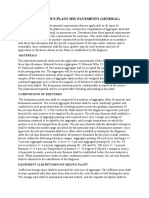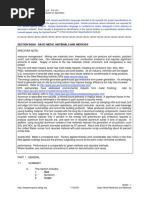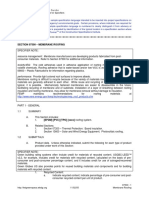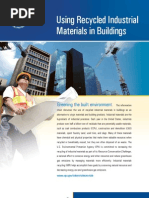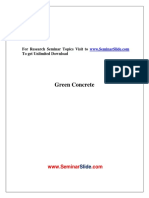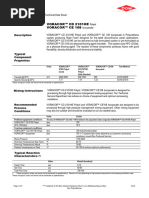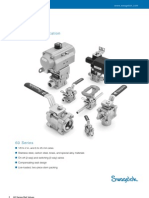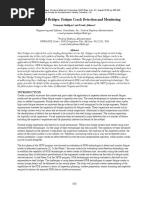Section 03300 - Cast-In-Place Concrete: Whole Building Design Guide Federal Green Construction Guide For Specifiers
Section 03300 - Cast-In-Place Concrete: Whole Building Design Guide Federal Green Construction Guide For Specifiers
Uploaded by
Anonymous NMytbMiDCopyright:
Available Formats
Section 03300 - Cast-In-Place Concrete: Whole Building Design Guide Federal Green Construction Guide For Specifiers
Section 03300 - Cast-In-Place Concrete: Whole Building Design Guide Federal Green Construction Guide For Specifiers
Uploaded by
Anonymous NMytbMiDOriginal Title
Copyright
Available Formats
Share this document
Did you find this document useful?
Is this content inappropriate?
Copyright:
Available Formats
Section 03300 - Cast-In-Place Concrete: Whole Building Design Guide Federal Green Construction Guide For Specifiers
Section 03300 - Cast-In-Place Concrete: Whole Building Design Guide Federal Green Construction Guide For Specifiers
Uploaded by
Anonymous NMytbMiDCopyright:
Available Formats
Whole Building Design Guide
Federal Green Construction Guide for Specifiers
This is a guidance document with sample specification language intended to be inserted into project specifications on
this subject as appropriate to the agency's environmental goals. Certain provisions, where indicated, are required for
U.S. federal agency projects. Sample specification language is numbered to clearly distinguish it from advisory or
discussion material. Each sample is preceded by identification of the typical location in a specification section where
TM
it would appear using the SectionFormat of the Construction Specifications Institute.
SECTION 03300 - CAST-IN-PLACE CONCRETE
SPECIFIER NOTE:
resource management: Improper mining of raw materials (aggregate and components of portland
cement: limestone, oxides of calcium silicon, clay, shale, and sand) can produce soil erosion, pollutant
runoff, and habitat loss. Materials for concrete and cement manufacture (aggregates, portland cement,
supplementary cementitious materials, and water) are found throughout the US, allowing for minimal
shipping distances, yet localized depletion of these resources may occur. Supplementary cementitious
materials consist of natural pozzolans and recycled products from other industries. Natural pozzolans
include: diatomaceous earths, volcanic ash, and pumicites. Recycled supplementary cementitious
content materials for pozzolanic concrete include: fly ash, slag cement, and silica fume. Recycled
concrete can also be used in concrete or as a subbase material.
Many cement manufacturing facilities are reducing their CO2 emissions through energy efficiency
improvements and through increased use of waste lime (instead of converting limestone to lime), and
scrap tires.
Resource efficient options for permanent formwork include earth forms and insulated, panels or blocks
made from expanded polystyrene (beads or extruded), known as insulated concrete forms. Temporary
forms (metal pan forms, wood forms, and corrugated paper forms) are generally reusable and easily
recyclable. Most typically contain recycled content.
toxicity/IEQ: The production of portland cement generates significant volumes of CO2, a significant
greenhouse gas.. By volume, a concrete mix typically consists of 10 to 15 percent portland cement or
other cementitious material. Some facilities have reduced their CO2 emissions through energy efficiency
improvements and through increased use of waste lime (instead of converting limestone to lime).
Approximately 50 percent of the kilns in North America use hazardous waste as fuel. Wastes such as
spent solvents, printing inks, paint residues, and cleaning fluids often are designated as hazardous
because they are flammable and have high fuel values. These materials can be burned to destruction as
fuel in a cement kiln at temperatures of about 2700 F (1480 C) while reducing the need to use fossil fuels.
There is controversy over the burning of waste materials (tires, MSW, and hazardous materials) in
cement kilns. The EPA and the Cement Kiln Recycling Coalition are addressing citizen concerns.
Concrete is relatively inert once cured. Admixtures, curing compounds, and sealers may emit VOCs,
especially during the curing process; however, virtually all emissions are eliminated before enclosing the
building.
Hazardous materials may also be "encapsulated" by being mixed with or imbedded in nonporous, durable
concrete, commonly known as solidification and stabilization. However, it is necessary to consider future
disassembly and possible options for recycling concrete that has "encapsulated" hazardous materials.
performance: Performance in place is comparable for green methods and standard methods. Concrete
construction provides thermal mass, fire resistance, and durable construction. The thermal mass effect
has been proven to reduce heating and cooling loads in most climates. Concrete structures can be
designed to last in excess of 100 years which will result in lower repair and reconstruction resources. The
coefficient of reflectivity of concrete allows reduced need for lighting and subsequent electricity when
used
http://fedgreenspecs.wbdg.org
11/02/05
03300 - 1
Cast-In-Place Concrete
Whole Building Design Guide
Federal Green Construction Guide for Specifiers
for paving of roads and parking areas. Steel reinforcing may be separated with magnets from concrete
aggregate during recycling operations. Separation of plastic from concrete aggregate may require water
to float plastic shards.
PART 1 - GENERAL
1.1
SUMMARY
A.
1.2
This Section includes:
1.
Formwork.
2.
Reinforcing.
3.
Cast-in-Place Concrete.
4.
Accessories.
SUBMITTALS
A.
Product data. Unless otherwise indicated, submit the following for each type of product
provided under work of this Section:
SPECIFIER NOTE:
Green building rating systems often include credit for materials of recycled content. USGBC-LEED
v2.2, for example, includes credit for materials with recycled content, calculated on the basis of preconsumer and post-consumer percentage content and it includes credit for use of salvaged/recovered
materials.
Green Globes US also provides points for reused building materials and components and for building
materials with recycled content.
1.
Recycled Content:
a.
Indicate recycled content; indicate percentage of pre-consumer and postconsumer recycled content per unit of product.
b.
Indicate relative dollar value of recycled content product to total dollar
value of product included in project.
c.
If recycled content product is part of an assembly, indicate the
percentage of recycled content product in the assembly by weight.
d.
If recycled content product is part of an assembly, indicate relative dollar
value of recycled content product to total dollar value of assembly.
SPECIFIER NOTE:
Specifying local materials may help minimize transportation impacts; however it may not have a
significant impact on reducing the overall embodied energy of a building material because of efficiencies
of scale in some modes of transportation.
Green building rating systems frequently include credit for local materials. Transportation impacts
include: fossil fuel consumption, air pollution, and labor.
USGBC-LEED v2.2 includes credits for materials extracted/harvested and manufactured within a 500
mile radius from the project site. Green Globes US also provides points for materials that are locally
manufactured.
Concrete ready-mix plants are so numerous across the US that they are generally within 50 miles (80 km)
of most job sites. Supplementary cementitious materials, portland cement, and the raw materials for
cement are also generally extracted and manufactured within 500 miles (800 km) of a job site.
2.
Local/Regional Materials:
a.
Sourcing location(s): Indicate location of extraction, harvesting, and
recovery; indicate distance between extraction, harvesting, and recovery
and the project site.
b.
Manufacturing location(s): Indicate location of manufacturing facility;
indicate distance between manufacturing facility and the project site.
http://fedgreenspecs.wbdg.org
11/02/05
03300 - 2
Cast-In-Place Concrete
Whole Building Design Guide
Federal Green Construction Guide for Specifiers
c.
d.
Product Value: Indicate dollar value of product containing local/regional
materials; include materials cost only.
Product Component(s) Value: Where product components are sourced
or manufactured in separate locations, provide location information for
each component. Indicate the percentage by weight of each component
per unit of product.
SPECIFIER NOTE:
The 2002 Farm Bill - Section 9002, Federal Procurement Of Biobased Products, requires each Federal
Agency to develop a procurement program which will assure that items composed of biobased products
will be purchased to the maximum extent practicable and which is consistent with applicable provisions of
Federal procurement law.
USGBC-LEED v2.2 includes credits for use of rapidly renewable materials, which USGBC describes as
plants harvested within a ten-year cycle. Green Globes US, provides credit for integration of materials
from renewable sources that have been selected based on life-cycle assessment.
3.
Biobased materials:
a.
Indicate type of biobased material in product.
b.
Indicate the percentage of biobased content per unit of product.
c.
Indicate relative dollar value of biobased content product to total dollar
value of product included in project.
SPECIFIER NOTE:
USGBC-LEED v2.2 includes credit for use of sustainably harvested wood certified under Forest
Stewardship Council Guidelines. Under LEED v2.2, a minimum of 50 percent of wood-based materials
and products incorporated into the Project must be certified in accordance with the Forest Stewardship
Council Guidelines. .
Green Globes US also provides points for wood products that originate from certified sources, such as,
Forest Stewardship Council, Sustainable Forestry Initiative, and the CSA Sustainable Forest
Management Program.
B.
Letter of Certification(s) for Sustainable Forestry:
1.
Forest Stewardship Council (FSC): Provide letter of certification signed by
lumber supplier. Indicate compliance with FSC "Principles for Natural Forest
Management" and identify certifying organization.
a.
Submit FSC certification numbers; identify each certified product on a
line-item basis.
b.
Submit copies of invoices bearing the FSC certification numbers.
2.
Sustainable Forestry Board: Provide letter of certification signed by lumber
supplier. Indicate compliance with the Sustainable Forestry Boards "Sustainable
Forestry Initiative" (SFI) and identify certifying organization.
a.
Submit SFI certification numbers; identify each certified product on a
line-item basis.
b.
Submit copies of invoices bearing the SFI certification numbers.
3.
Canadian Standards Association (CSA): Provide letter of certification signed by
lumber supplier. Indicate compliance with the CSA and identify certifying
organization.
a.
Submit CSA certification numbers; identify each certified product on a
line-item basis.
b.
Submit copies of invoices bearing the CSA certification numbers.
PART 2 - PRODUCTS
2.1
FORMWORK
A.
Wood forms:
http://fedgreenspecs.wbdg.org
11/02/05
03300 - 3
Cast-In-Place Concrete
Whole Building Design Guide
Federal Green Construction Guide for Specifiers
1.
2.
Lumber as specified in Section 06100.
Sheathing as specified in Section 06160.
B.
Plastic forms: Plastic lumber as specified in Section 06600 Plastic Fabrications.
SPECIFIER NOTE:
Green building rating systems often include credit for materials of recycled content and may distinguish
allowable credit for post-consumer and post-industrial (or pre-consumer) recycled content. USGBCLEED v2.2, for example, factors 100 percent of post-consumer recycled content but only 50 percent of
pre-consumer (post-industrial) recycled content into calculations for its recycled content materials credit.
LEED v2.2 grants one credit to a project for using materials with recycled content such that the sum of
post-consumer recycled content plus one-half of the post-industrial content constitutes at least 10 percent
of the total value of the materials in the project; 10% (post-consumer + 1/2 post-industrial). It grants an
additional point for 20% (post-consumer + 1/2 post-industrial).
Green Globes US also provides points for reused building materials and components and for building
materials with recycled content.
Recycled content is typically determined by calculating the weight of the recycled material divided by the
total weight of the product and expressed as a percentage by weight. (The recycled content value of a
product as assessed under LEED is determined by multiplying the recycled content percentage and the
cost of the product.)
Supplementary cementitious materials, such as fly ash, silica fume, and slag cement are typically
considered pre-consumer recycled material. Furthermore, using recycled aggregates such as slag
instead of extracted aggregates may qualify as pre-consumer. Using recycled concrete as aggregates
may qualify as post-consumer.
Verify with manufacturer for product availability and recycled content.
1.
Recycled Content: Minimum [5] [10] [xxxx] percent post-consumer recycled
content, or minimum [20] [40] [xxxx] percent pre-consumer recycled content at
contractors option.
C.
Insulating Concrete Forms:
SPECIFIER NOTE:
The Expanded Polystyrene (EPS) used in insulating concrete forms are not typically made from recycled
material. However, the plastic webs and connectors may be made from recycled material.
Verify with manufacturer for product availability and recycled content.
1.
Recycled Content: Minimum [5] [10] [xxxx] percent post-consumer recycled
content, or minimum [20] [40] [xxxx] percent pre-consumer recycled content at
contractors option.
2.
Toxicity/IEQ: No CFCs, HCFCs and other ozone-depleting substances used or
released during manufacture.
D.
Carton forms: Moisture resistant treated paper faces, biodegradable, structurally
sufficient to support weight of wet concrete until initial set.
1.
Recycled Content: Minimum [5] [10] [xxxx] percent post-consumer recycled
content, or minimum [20] [40] [xxxx] percent pre-consumer recycled content at
contractors option.
E.
Form Release Agent: Colorless biobased oil which will not stain concrete.
SPECIFIER NOTE:
According to the June 7, 2002 Draft of the USDA Biobased Products Definitions and Descriptions,
minimum biobased content per item category might be defined as follows:
construction materials: 85 percent;
composite board: 70 percent;
landscaping materials: 100 percent;
compost: 100 percent;
adhesives: 80 percent;
http://fedgreenspecs.wbdg.org
11/02/05
03300 - 4
Cast-In-Place Concrete
Whole Building Design Guide
Federal Green Construction Guide for Specifiers
furniture: can be designated as biobased products if 90 percent of all of the adhesives used in the
production are biobased adhesives.
For current designations under the Federal Biobased Products Preferred Procurement Program (FB4P),
refer to www.biobased.oce.usda.gov. As of March 16, 2006, the Federal Register includes the final rule
designating the first six items, which are generic groupings of biobased products. The items are: mobile
equipment hydraulic fluids; biobased roof coatings; water tank coatings; diesel fuel additives; penetrating
lubricants, and; bedding, bed linens and towels. Refer to 7 CFR Part 2902, Designation of Biobased
Items for Federal Procurement; Final Rule. The requirements for purchasing biobased items apply to
those items directly purchased by the federal agency. Under a construction contract, the contractor's use
of hydraulic fluid in its bulldozers and backhoes is incidental to the purpose of its contract, so the
contractor is not required to use biobased hydraulic fluids. The Office of the Federal Environmental
Executive (OFEE) recommends that agencies encourage the use of these items, however.
This is the first of a series of rules that will be issued designating biobased items. The USDA currently
has identified about 150 items for which it is collecting test data needed for the additional designations of
items that will extend preferred procurement status to include all qualifying biobased products.
1.
Biobased Content: Minimum [85] [xxxx] percent soy-based oil or other biobased
material.
2.
Toxicity/IEQ: [Low] [Zero] VOC.
2.2
REINFORCING
SPECIFIER NOTE:
US-EPA Comprehensive Procurement Guidelines (CPG) discusses steel manufactured in either a Basic
Oxygen Furnace (BOF) or an Electric Arc Furnace (EAF). Steel from the BDF process contains 25-30
percent total recovered materials, of which 16 percent is post-consumer steel. Steel from the EAF
process contains a total of 100 percent recovered steel, of which 67 percent is post-consumer. Most
reinforcing bar in the US is manufactured from recycled steel.
Recommendations for recycled content in steel reinforcing are not stated.
A.
Steel Reinforcing:
1.
Recycled Content: Minimum [5] [10] [xxxx] percent post-consumer recycled
content, or minimum [20] [40] [xxxx] percent pre-consumer recycled content at
contractors option.
2.3
B.
Fibrous Reinforcing: [Plastic] [Steel]
1.
Recycled Content: Minimum [5] [10] [xxxx] percent post-consumer recycled
content, or minimum [20] [40] [xxxx] percent pre-consumer recycled content at
contractors option.
C.
Chairs and bolsters: [Plastic] [Steel]
1.
Recycled Content: Minimum [5] [10] [xxxx] percent post-consumer recycled
content, or minimum [20] [40] [xxxx] percent pre-consumer recycled content at
contractors option.
CONCRETE MATERIALS
SPECIFIER NOTE:
Coal fly ash is a byproduct of coal burning at electric utility plants. It is called "fly" ash because it is
transported from the combustion chamber by exhaust gases. Slag is a byproduct of iron blast furnaces.
The hot slag is quenched with water and ground into granules finer than Portland cement. The resulting
product, called slag cement, can be used as an ingredient in concrete. Typical replacement rates are
discussed on the Slag Cement Associations website: http://www.slagcement.org/proportioning.htm. Aircooled slag can be used as an aggregate in concrete.
US-EPA Comprehensive Procurement Guidelines (CPG) recommend allowing for the use of coal fly ash
or slag cement, as appropriate. Due to variations in coal fly ash, slag, cement, strength requirements,
http://fedgreenspecs.wbdg.org
11/02/05
03300 - 5
Cast-In-Place Concrete
Whole Building Design Guide
Federal Green Construction Guide for Specifiers
costs, and construction practices, EPA does not recommend recovered materials content levels for
cement or concrete containing coal fly ash or slag.
A.
Fly ash: Comply with ASTM C618; Class [N] [F] [C]. Report the chemical analysis of the
fly ash in accordance with ASTM C311. Evaluate and classify fly ash in accordance with
ASTM D5759.
1.
Recycled Content: Minimum [20] [40] [xxxx] percent pre-consumer recycled
content at contractors option.
2.3
2.4
B.
Slag Cement: Comply with ASTM C989; Grade [80] [100] [120].
1.
Recycled Content: Minimum [20] [40] [xxxx] percent pre-consumer recycled
content at contractors option.
C.
Silica Fume: Comply with ASTM C1240.
1.
Recycled Content: Minimum [20] [40] [xxxx] percent pre-consumer recycled
content at contractors option.
D.
Aggregate: Recycled porcelain, concrete, stone, or other recycled content material
conforming to requirements of mix design.
1.
Recycled Content: Minimum [5] [10] [xxxx] percent post-consumer recycled
content, or minimum [20] [40] [xxxx] percent pre-consumer recycled content at
contractors option.
ACCESSORIES
A.
Curing Compounds, Sealers, and coatings: Water-based.
1.
Toxicity/IEQ: [Low] [Zero] VOC.
B.
Isolation Joints: [Rubber] [Cellulose] [xxxx].
1.
Recycled Content: Minimum [5] [10] [xxxx] percent post-consumer recycled
content, or minimum [20] [40] [xxxx] percent pre-consumer recycled content at
contractors option.
FINISHED CONCRETE
SPECIFIER NOTE:
Silica fume is very fine pozzolanic material produced by electric arc furnaces as a byproduct of production
of elemental silicon or ferro-silicon alloys. Silica fume is usually used as a replacement for 5 to 7 percent
of the Portland cement. Replacement levels higher than 10 percent can lead to workability issues.
Replacement rates of coal fly ash for cement in the production of blended cement generally do not
exceed 20-30 percent, although coal fly ash blended cements may range from 0-40 percent coal fly ash
by weight, according to ASTM C 595, for cement Types IP and I(PM). 15 percent is a more accepted rate
when coal fly ash is used as a partial cement replacement as an admixture in concrete.
According to ASTM C 595, ground granulated blast furnace slag (GGBF slag) may replace up to 70
percent of the Portland cement in some concrete mixtures. Most GGBF slag concrete mixtures contain
between 25 and 50 percent GGBF slag by weight.
US-EPA Comprehensive Procurement Guidelines (CPG) recommend allowing for the use of coal fly ash
or slag cement, as appropriate.
Verify mix design as appropriate to project engineering requirements.
A.
Mix Design: Comply with ASTM C 595. Provide the following in lieu of Portland cement:
1.
Fly ash: Provide at a replacement rate of [15] [xx] percent.
2.
Slag Cement: provide at a replacement rate of [25] [xx] percent.
3.
Silica Fume: Provide at a replacement rate of [5] [xx] percent.
PART 3 - EXECUTION
http://fedgreenspecs.wbdg.org
11/02/05
03300 - 6
Cast-In-Place Concrete
Whole Building Design Guide
Federal Green Construction Guide for Specifiers
3.X
SITE ENVIRONMENTAL PROCEDURES
SPECIFIER NOTE:
Concrete admixtures are now available that retard the setting of concrete so effectively that a partial load
can be brought back to the ready mix plant for one or two days then reactivated for use. Cured waste
concrete still possesses an active cement ingredient which reduces the required virgin cement in
recovered content mixes by 3 to 10 percent. Despite the recycling potential for concrete, most concrete
waste in the U.S (approximately 67 percent by weight, 53 percent by volume) is landfilled. However, in
many urban areas, concrete can no longer be accepted in landfills.
A.
Waste Management: As specified in Section 01351 Waste Management and as
follows:
1.
Formwork: Reuse forms to greatest extent possible without damaging structural
integrity of concrete and without damaging aesthetics of exposed concrete.
2.
Mixing equipment: Return excess concrete to supplier; minimize water used to
wash equipment.
3.
Moisture curing: Prevent water run-off.
4.
Hardened, cured waste concrete: [Hardened, cured waste concrete may be
crushed and reused as fill or as a base course for pavement.] [Hardened,
cured waste concrete may be used as aggregate in concrete mix if
approved by Engineer.]
END OF SECTION
http://fedgreenspecs.wbdg.org
11/02/05
03300 - 7
Cast-In-Place Concrete
You might also like
- Snell's Law WorksheetDocument2 pagesSnell's Law WorksheetCamille Rose Basbas100% (1)
- Construction Plant DBT Module 1 NotesDocument12 pagesConstruction Plant DBT Module 1 NotesDEDAN KIMATHI100% (1)
- Section 08210 - Wood Doors: Whole Building Design Guide Federal Green Construction Guide For SpecifiersDocument5 pagesSection 08210 - Wood Doors: Whole Building Design Guide Federal Green Construction Guide For SpecifiersAnonymous NMytbMiDNo ratings yet
- Backing BearingsDocument8 pagesBacking BearingsJurun_BidanshiNo ratings yet
- ASM Handbook Volume 4C: Induction Heating and Heat TreatmentDocument9 pagesASM Handbook Volume 4C: Induction Heating and Heat TreatmentJaime Falagan100% (1)
- Section 04200 - Masonry: Whole Building Design Guide Federal Green Construction Guide For SpecifiersDocument4 pagesSection 04200 - Masonry: Whole Building Design Guide Federal Green Construction Guide For SpecifiersAnonymous NMytbMiDNo ratings yet
- Section 09250 - Gypsum Board: Whole Building Design Guide Federal Green Construction Guide For SpecifiersDocument3 pagesSection 09250 - Gypsum Board: Whole Building Design Guide Federal Green Construction Guide For SpecifiersAnonymous NMytbMiDNo ratings yet
- Section 09510 - Acoustical Ceilings: Whole Building Design Guide Federal Green Construction Guide For SpecifiersDocument5 pagesSection 09510 - Acoustical Ceilings: Whole Building Design Guide Federal Green Construction Guide For SpecifiersAnonymous NMytbMiDNo ratings yet
- Section 05050 - Basic Metal Materials and MethodsDocument4 pagesSection 05050 - Basic Metal Materials and MethodsAnonymous NMytbMiD0% (1)
- Section 09720 - Wallcovering: Whole Building Design Guide Federal Green Construction Guide For SpecifiersDocument4 pagesSection 09720 - Wallcovering: Whole Building Design Guide Federal Green Construction Guide For SpecifiersAnonymous NMytbMiDNo ratings yet
- Section 07500 - Membrane Roofing: Whole Building Design Guide Federal Green Construction Guide For SpecifiersDocument5 pagesSection 07500 - Membrane Roofing: Whole Building Design Guide Federal Green Construction Guide For SpecifiersAnonymous NMytbMiDNo ratings yet
- Section 02795 Porous Paving: Whole Building Design Guide Federal Green Construction Guide For SpecifiersDocument6 pagesSection 02795 Porous Paving: Whole Building Design Guide Federal Green Construction Guide For SpecifiersAnonymous NMytbMiDNo ratings yet
- Section 08500 - Windows: Whole Building Design Guide Federal Green Construction Guide For SpecifiersDocument7 pagesSection 08500 - Windows: Whole Building Design Guide Federal Green Construction Guide For SpecifiersAnonymous NMytbMiDNo ratings yet
- SECTION 09650 Resilient Flooring: Whole Building Design Guide Federal Green Construction Guide For SpecifiersDocument5 pagesSECTION 09650 Resilient Flooring: Whole Building Design Guide Federal Green Construction Guide For SpecifiersAnonymous NMytbMiDNo ratings yet
- What Is Green Concrete PDFDocument3 pagesWhat Is Green Concrete PDFVelchuri SairamNo ratings yet
- Section 06070 - Wood Treatment: Resource ManagementDocument5 pagesSection 06070 - Wood Treatment: Resource ManagementAnonymous NMytbMiDNo ratings yet
- Section 09654 - Linoleum: Whole Building Design Guide Federal Green Construction Guide For SpecifiersDocument6 pagesSection 09654 - Linoleum: Whole Building Design Guide Federal Green Construction Guide For SpecifiersAnonymous NMytbMiDNo ratings yet
- Section 12700 - Systems Furniture: Whole Building Design Guide Federal Green Construction Guide For SpecifiersDocument11 pagesSection 12700 - Systems Furniture: Whole Building Design Guide Federal Green Construction Guide For SpecifiersAnonymous NMytbMiDNo ratings yet
- Resource Management:: Section 07900 - Joint SealantsDocument3 pagesResource Management:: Section 07900 - Joint SealantsAnonymous NMytbMiDNo ratings yet
- Resource Management: toxicity/IEQ: Performance:: Section 10170 - Plastic Toilet CompartmentsDocument5 pagesResource Management: toxicity/IEQ: Performance:: Section 10170 - Plastic Toilet CompartmentsAnonymous NMytbMiDNo ratings yet
- Using Recycled Industrial Materials in Buildings: Greening The Built EnvironmentDocument4 pagesUsing Recycled Industrial Materials in Buildings: Greening The Built EnvironmentYusup Rendy WidiantoroNo ratings yet
- LEED Cover Letter For BID PKGDocument2 pagesLEED Cover Letter For BID PKGIlde Brando Leoncito AdarloNo ratings yet
- Green Concrete: K.L.E. College of Engineering and Technology 1Document26 pagesGreen Concrete: K.L.E. College of Engineering and Technology 1Mohak NagraniNo ratings yet
- Section 06160 - Sheathing: Resource ManagementDocument5 pagesSection 06160 - Sheathing: Resource ManagementAnonymous NMytbMiDNo ratings yet
- Presentation 6Document14 pagesPresentation 6Kandagatla KamalNo ratings yet
- Eco Concrete Opportunities and ChallengesDocument22 pagesEco Concrete Opportunities and ChallengesVinay Gupta100% (1)
- Green ConcreteDocument22 pagesGreen ConcreteSyafiq ArtNo ratings yet
- Green Concrete: WWW - SeminarDocument12 pagesGreen Concrete: WWW - SeminarSuraj Deb BarmaNo ratings yet
- Green Concrete and Sustainability of Environmental System - Yash KrishiDocument8 pagesGreen Concrete and Sustainability of Environmental System - Yash KrishiSree NivasNo ratings yet
- Life Cycle Inventory of Slag Cement ConcreteDocument26 pagesLife Cycle Inventory of Slag Cement ConcreteGopala RaoNo ratings yet
- Green ConcreteDocument12 pagesGreen Concretevaishnavi yedur100% (1)
- Carbon Footprint of Concrete Buildings Seen in The Life Cycle Perspective PDFDocument14 pagesCarbon Footprint of Concrete Buildings Seen in The Life Cycle Perspective PDFGoodson ChitsaNo ratings yet
- Resource Management: toxicity/IEQ:: Section 15800 - Air DistributionDocument5 pagesResource Management: toxicity/IEQ:: Section 15800 - Air DistributionAnonymous NMytbMiDNo ratings yet
- Specifying Sustainable ConcreteDocument26 pagesSpecifying Sustainable ConcreteEtienne MagriNo ratings yet
- Green Concrete For Sustainable ConstructionDocument5 pagesGreen Concrete For Sustainable ConstructionInternational Journal of Research in Engineering and TechnologyNo ratings yet
- Fgs 313100Document6 pagesFgs 313100Lionel Carel Tchiendjo TchanagNo ratings yet
- Building Green With ConcreteDocument6 pagesBuilding Green With Concretemugu12No ratings yet
- Green Concrete: A Seminar Report OnDocument13 pagesGreen Concrete: A Seminar Report OnUmange RanasingheNo ratings yet
- Thesis BookDocument5 pagesThesis BookFarjana BariNo ratings yet
- Fgs 051000Document8 pagesFgs 051000Otceliban SarlNo ratings yet
- Industry Standard R Value Calculator11Document28 pagesIndustry Standard R Value Calculator11Tanmay ShrimaliNo ratings yet
- HMT CepDocument10 pagesHMT Cep2020me200.mohammed.yousefNo ratings yet
- Effects On Compressive Strength When Cement Is Partially Replaced by Fly-AshDocument10 pagesEffects On Compressive Strength When Cement Is Partially Replaced by Fly-AshInternational Organization of Scientific Research (IOSR)No ratings yet
- US Epa SuggestionsDocument4 pagesUS Epa SuggestionsVivek Chowdary ChennupatiNo ratings yet
- Green 070415Document52 pagesGreen 070415tcthomasNo ratings yet
- Khush BakhtDocument26 pagesKhush BakhtMuhammad YousafNo ratings yet
- K. Bargaheiser - Corrosion PaperDocument16 pagesK. Bargaheiser - Corrosion PaperJHON WILMAR CARDENAS PULIDONo ratings yet
- Study of Structural Performance and Durability of Concrete by Partial Replacement of Cement With Hypo Sludge (Paper Waste)Document5 pagesStudy of Structural Performance and Durability of Concrete by Partial Replacement of Cement With Hypo Sludge (Paper Waste)Innovative Research PublicationsNo ratings yet
- Login Create An Account Advertise With Us Contact Us About Us HomeDocument17 pagesLogin Create An Account Advertise With Us Contact Us About Us Homejagadeesh suraNo ratings yet
- Architectural Concrete Specification 033300Document24 pagesArchitectural Concrete Specification 033300julianborchardt2No ratings yet
- What Is Carbon Foot Print?Document5 pagesWhat Is Carbon Foot Print?mnagasandeepNo ratings yet
- Salgado Ve Silva 2022 Recycled Aggregates From Construction and Demolition Waste Towards An Application On Structural Concrete A ReviewDocument20 pagesSalgado Ve Silva 2022 Recycled Aggregates From Construction and Demolition Waste Towards An Application On Structural Concrete A ReviewBurak BulutNo ratings yet
- Earthworks in Landfill EngineeringDocument66 pagesEarthworks in Landfill EngineeringMelissa GrahamNo ratings yet
- Geopolymer Pavement Block Using M-SandDocument7 pagesGeopolymer Pavement Block Using M-SandIRJMETS JOURNALNo ratings yet
- Sustainability Assignment ENGG1000 Janush AdabjouDocument7 pagesSustainability Assignment ENGG1000 Janush AdabjouJanush AbadjouNo ratings yet
- Phu Bui Fly Ash Coal PaperDocument6 pagesPhu Bui Fly Ash Coal PaperBùi Gia PhúNo ratings yet
- CCD 151framingmaterialsandassemblies (E)Document10 pagesCCD 151framingmaterialsandassemblies (E)Usama AwadNo ratings yet
- Gartner. Cem Concr Res 2004Document10 pagesGartner. Cem Concr Res 2004Smeetha KaurNo ratings yet
- Cement & Concrete CompositesDocument14 pagesCement & Concrete CompositesPurandhar ReddiNo ratings yet
- Clean Ironmaking and Steelmaking Processes: Efficient Technologies for Greenhouse Emissions AbatementFrom EverandClean Ironmaking and Steelmaking Processes: Efficient Technologies for Greenhouse Emissions AbatementNo ratings yet
- Materials for Sustainable Sites: A Complete Guide to the Evaluation, Selection, and Use of Sustainable Construction MaterialsFrom EverandMaterials for Sustainable Sites: A Complete Guide to the Evaluation, Selection, and Use of Sustainable Construction MaterialsNo ratings yet
- Sustainability in Structural Concrete DesignFrom EverandSustainability in Structural Concrete DesignJorge de BritoNo ratings yet
- Going Green Construction: An Insider's Look at the Trend in Green ConstructionFrom EverandGoing Green Construction: An Insider's Look at the Trend in Green ConstructionNo ratings yet
- DEER User's GuideDocument21 pagesDEER User's GuideAnonymous NMytbMiDNo ratings yet
- Section 09654 - Linoleum: Whole Building Design Guide Federal Green Construction Guide For SpecifiersDocument6 pagesSection 09654 - Linoleum: Whole Building Design Guide Federal Green Construction Guide For SpecifiersAnonymous NMytbMiDNo ratings yet
- Section 11450 - Residential Equipment: Whole Building Design Guide Federal Green Construction Guide For SpecifiersDocument4 pagesSection 11450 - Residential Equipment: Whole Building Design Guide Federal Green Construction Guide For SpecifiersAnonymous NMytbMiDNo ratings yet
- Section 07500 - Membrane Roofing: Whole Building Design Guide Federal Green Construction Guide For SpecifiersDocument5 pagesSection 07500 - Membrane Roofing: Whole Building Design Guide Federal Green Construction Guide For SpecifiersAnonymous NMytbMiDNo ratings yet
- SECTION 09650 Resilient Flooring: Whole Building Design Guide Federal Green Construction Guide For SpecifiersDocument5 pagesSECTION 09650 Resilient Flooring: Whole Building Design Guide Federal Green Construction Guide For SpecifiersAnonymous NMytbMiDNo ratings yet
- Section 08500 - Windows: Whole Building Design Guide Federal Green Construction Guide For SpecifiersDocument7 pagesSection 08500 - Windows: Whole Building Design Guide Federal Green Construction Guide For SpecifiersAnonymous NMytbMiDNo ratings yet
- Section 12700 - Systems Furniture: Whole Building Design Guide Federal Green Construction Guide For SpecifiersDocument11 pagesSection 12700 - Systems Furniture: Whole Building Design Guide Federal Green Construction Guide For SpecifiersAnonymous NMytbMiDNo ratings yet
- Resource Management:: Section 11680 - Office EquipmentDocument4 pagesResource Management:: Section 11680 - Office EquipmentAnonymous NMytbMiDNo ratings yet
- Resource Management: toxicity/IEQ: Performance:: Section 10170 - Plastic Toilet CompartmentsDocument5 pagesResource Management: toxicity/IEQ: Performance:: Section 10170 - Plastic Toilet CompartmentsAnonymous NMytbMiDNo ratings yet
- Glass and EnergyDocument57 pagesGlass and EnergyAnonymous NMytbMiDNo ratings yet
- AC7122.4 Rev ADocument20 pagesAC7122.4 Rev ANamelezz ShadowwNo ratings yet
- Tyco - Hot Melt AdhesivesDocument3 pagesTyco - Hot Melt Adhesivesjaredf@jfelectric.comNo ratings yet
- ME-311 Cotter and Coupling - 2018Document2 pagesME-311 Cotter and Coupling - 2018VishnuNo ratings yet
- Nanjangud Industrial Symbiosis Report PDFDocument50 pagesNanjangud Industrial Symbiosis Report PDFsandeepdeepu100% (1)
- Class 12 Chemistry ProjectDocument16 pagesClass 12 Chemistry Projectfaizank2379No ratings yet
- Lecture - 3 - Heat and The First Law Example ProblemsDocument22 pagesLecture - 3 - Heat and The First Law Example ProblemsifiokNo ratings yet
- Autovillage Area Rate Analysis 21 SepDocument116 pagesAutovillage Area Rate Analysis 21 Seprashmi bhailaNo ratings yet
- Voracor CD 2101he TDS From Voracor CD 2102 PolyolDocument3 pagesVoracor CD 2101he TDS From Voracor CD 2102 PolyolHugo Sanchez HuertaNo ratings yet
- Caustic Management and Reuse in The Beverage Bottling IndustryDocument52 pagesCaustic Management and Reuse in The Beverage Bottling IndustrydingobkNo ratings yet
- MS 01 146Document32 pagesMS 01 146Umar SchadonNo ratings yet
- Chemistry Student's Book AnswersDocument14 pagesChemistry Student's Book AnswersChoudhry WalidNo ratings yet
- E1235Document5 pagesE1235LLNo ratings yet
- Nde of Steel Bridges Fatigue Crack Detection and MonitoringDocument8 pagesNde of Steel Bridges Fatigue Crack Detection and MonitoringHyujeii MceNo ratings yet
- 26NiCrMoV14 5Document3 pages26NiCrMoV14 5arash_asasaNo ratings yet
- Statistical Tables On CMWPI For December 2021Document8 pagesStatistical Tables On CMWPI For December 2021Claire NecesitoNo ratings yet
- Martensitic Transformations in Shape-Memory Alloys. Successes and Failures of Thermal Analysis and CalorimetryDocument26 pagesMartensitic Transformations in Shape-Memory Alloys. Successes and Failures of Thermal Analysis and CalorimetrySrinivasan NarayananNo ratings yet
- Process Flow of ECHDocument2 pagesProcess Flow of ECHAkshay PatelNo ratings yet
- Chemical Compatibility Guide: First Choice When Quality CountsDocument28 pagesChemical Compatibility Guide: First Choice When Quality CountsYavuz SolmazNo ratings yet
- Instrument Tube Fitting Instalation Manual PDFDocument76 pagesInstrument Tube Fitting Instalation Manual PDFjhonny sanchezNo ratings yet
- Determination of Forming Limit Diagram For Aisi 1008 Steel Sheet by Theoratical, Experimental and Fea MethodDocument7 pagesDetermination of Forming Limit Diagram For Aisi 1008 Steel Sheet by Theoratical, Experimental and Fea Methodnsk143446No ratings yet
- CCWTLDocument20 pagesCCWTLHardikNo ratings yet
- Skd-S2 Non-Aqueous Developer: Product Data SheetDocument2 pagesSkd-S2 Non-Aqueous Developer: Product Data Sheetbachrul ulumNo ratings yet
- Standard Specs 15 STD Spec For Positive Material Identi Rev 0Document9 pagesStandard Specs 15 STD Spec For Positive Material Identi Rev 0sumit kumarNo ratings yet
- Parámetros Hoek Brown TipicosDocument1 pageParámetros Hoek Brown TipicosRodrigo Muñoz ValderramaNo ratings yet
- Post CoolingDocument9 pagesPost CoolingMyname AtNo ratings yet
- 3 NEPROPLAST CPVC PipesFlowGuard EmailDocument12 pages3 NEPROPLAST CPVC PipesFlowGuard EmailperezismaelNo ratings yet

